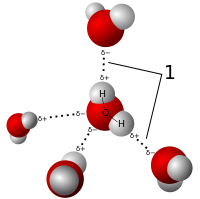
Photo from wikipedia
Abstract Nb solute behavior and its effect on grain size stabilization in Cu-Nb alloys was studied using a combination of Vickers hardness testing, x-ray diffraction measurements, transmission electron microscopy and… Click to show full abstract
Abstract Nb solute behavior and its effect on grain size stabilization in Cu-Nb alloys was studied using a combination of Vickers hardness testing, x-ray diffraction measurements, transmission electron microscopy and atom probe tomography (APT). Cu-Nb alloys with concentrations in the range of 1 to 10 at.% Nb were studied after annealing at 400 °C and 800 °C. The grain growth resistance at both temperatures increased with an increase in Nb solute content. For instance, after annealing at 800 °C (0.74 Tm), Cu-1Nb, Cu-5Nb and Cu-10Nb have a grain size that is ∼8, ∼14 and ∼14 times respectively smaller than that of unalloyed Cu. This resistance is attributed to the formation of Nb-oxide-based clusters, elemental Nb segregation zones and large elemental (Nb)-based precipitates as observed by APT. The Nb-oxide-based clusters are the precursors of phase separation and form due to a reaction with oxygen, which is a contaminant from the milling process. Once the oxygen is consumed, the process continues and the grain boundaries accumulate more solute and begin to thicken into elemental Nb segregation zones. Eventually, Nb solute phase separates and forms Nb-based precipitates. After annealing at 400 °C and 800 °C, Cu-5Nb has a hardness which is approximately 2.5 times and 3 times respectively that of the hardness of unalloyed Cu after an equivalent anneal. This increase has been attributed to Hall-Petch strengthening and precipitation strengthening.
Journal Title: Acta Materialia
Year Published: 2017
Link to full text (if available)
Share on Social Media: Sign Up to like & get
recommendations!